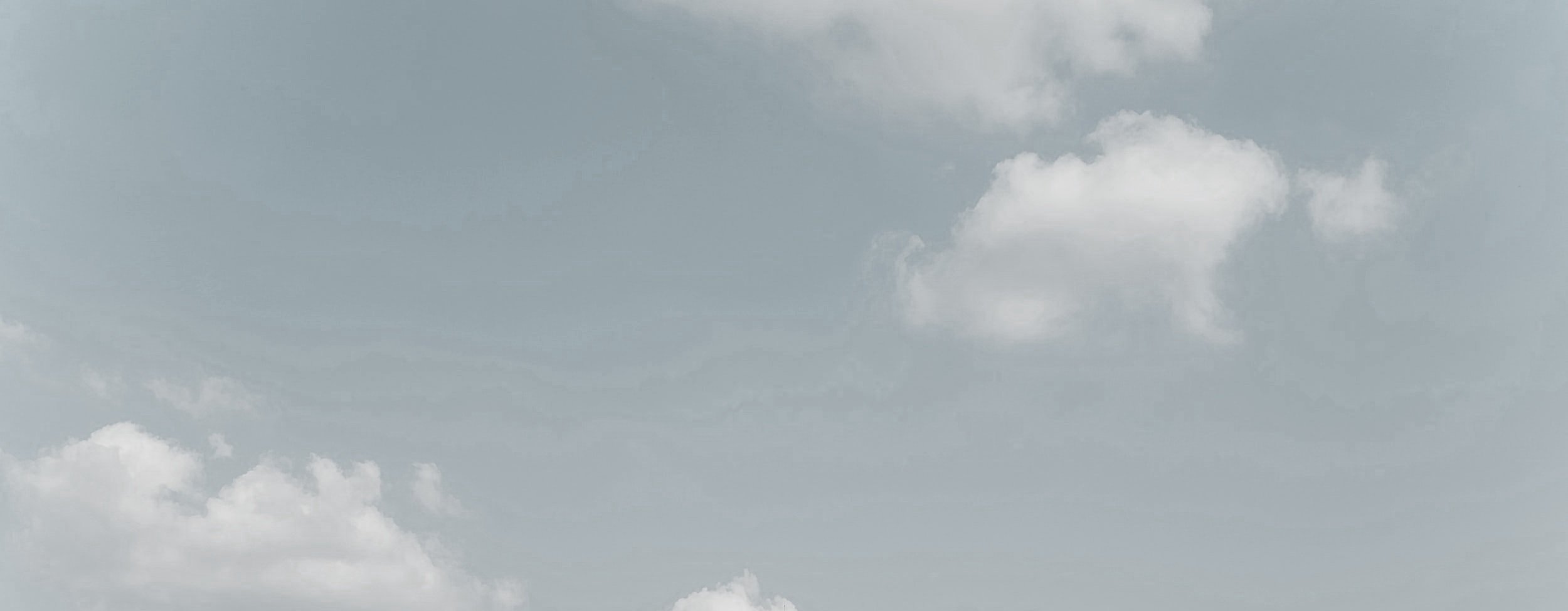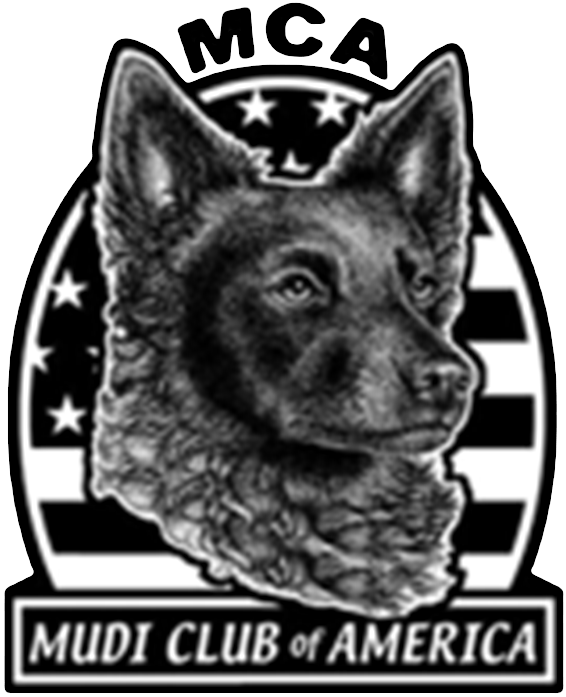
Mudi Breed Standard
AKC Standard
GENERAL APPEARANCE
The Mudi is an extremely versatile, intelligent, alert, agile all-purpose Hungarian farm dog. Medium sized, moderate inconformation, slightly longer than tall with a slightly sloping topline from withers to croup. Wedge-shaped head and prick ears. The distinctive low maintenance coat is very wavy to slightly curly on the body and is short and straight on the face and front of the legs. There are variations in color and tail length.
SIZE, PROPORTION, SUBSTANCE
Height is measured from withers to the ground and is slightly longer than tall when measured from point of shoulder to point of buttocks. The brisket comes to the elbow and is slightly less than length of leg. Substance – The Mudi is medium boned. Size – Dogs are from 15 ½ inches to 19 inches, bitches from 14 ½ inches to 18 inches. Ideal height for dogs is 17 ½, for bitches is 16 ½. Disqualification – Over or under listed height.
HEAD
The head is wedge shaped when viewed from the top and from the side with sufficient fill under the eyes to make a smooth wedge line from ear to nose. The length of the muzzle is slightly less than half of the total length of the head. The stop is defined but not obvious. Expression – A “daredevil”, lively, intelligent and alert expression. Eyes – The almond shaped eyes, as dark as possible, are set slightly obliquely.The rims of lids are tight, close-fitting to the eyeball and completely pigmented. Eye Color: Black Dogs – Dark as possible. Merle – Brown, blue or partially blue eyes. Brown, gray and gray-brown may have lighter brown eyes. Yellow and white dogs may have brown, blue or partially blue eyes. Eye Rim Pigment: Black Dogs – Black. Merle Dogs – Match base color. Brown and gray-brown – Brown. Gray dogs – Gray. Disqualification – Incomplete or pink pigmentation of the eyes and eye rims, yellow eyes in black dogs. Ears – Ears are high set, fully erect and covered with abundant hair reaching beyond the edges of the ear leather. The ears are triangular and only slightly taller than the width at the base. The ears are very mobile and alert, able to move independently in reaction to any stimulation. Disqualification –Drop or semi-pricked ears.
Skull – The skull and forehead are slightly rounded. The occiput and brows are only slightly apparent. Muzzle – The muzzle is strong with the bridge of the nose straight and tapering to a blunt end at the nose. Whiskers shall be present and may be curly. Nose – Nose Color: Black Dogs – Black nose. Brown and gray- brown dogs – Brown nose. Gray dogs – Gray nose. Yellow and white colored dogs – Black, brown or gray nose. The nose pigmentation is complete. Disqualification– Pink or spotted nose. Bite – Scissors bite. Fault – One or more missing teeth are a serious fault. Disqualification –Over or under shot mouth, wry mouth.
NECK, TOPLINE AND BODY
The slightly high set neck is of medium length, barely arched and well-muscled. The skin at the throat is tight, dry,and without a dewlap. Topline – Withers are slightly higher with the topline slightly sloping towards the croup. Body– The body is smooth and tight with hard, but not bulging muscles. Forechest is slightly curved, the point of the sternum only slightly protruding. The chest is moderate in depth with ribs that are slightly sprung that extends back to a slight tuck-up. The back is medium length, straight and taut. The loin is short, firmly coupled. The croup is slightly sloped, and of medium breadth. The tail follows the natural line of the croup. Tail – All tail lengths are acceptable, none is preferred over any other. The tail can be carried over the back in a loose, semi-circular fashion. When relaxed all tail lengths may hang below the topline. The tail is abundantly coated; the hair on the underside can be 4 to 5 inches long. Fault – A tightly curled tail or “pigs-tail” should be faulted.
FOREQUARTERS
The shoulders are moderately angulated (100-110 degrees), with long, well-knit shoulder blades and an upper armmatching in length. The elbows are tucked firmly against the brisket. The pastern is very slightly sloped. Feet are compact, oval in shape; pads deep and strong, toes moderately arched and close. The nails are hard and strong. Front dewclaws are desirable.
HINDQUARTERS
The hindquarters are well-developed and muscular, and in balance with the forequarters having moderate angulation. The hocks are short, vertical, and parallel to each other. Hind feet same as the forefeet. Rear dewclaws are not desirable.
COAT
Face and front of legs are covered by short, straight and smooth hair. On other parts of the body, the coat is very wavy to slightly curly, dense and about 1 inch to 3 inches long. At some spots, cow-licks and ridges are formed. The coat is longer on the back of the forearms and the upper thighs, where it forms pronounced featherings. The weather resistant coat is presented naturally, never sculpted, fluffed nor blown dry. Disqualification – Short, smooth or straight coat on the whole body; long hair on the face.
COLOR
No color is preferred over any other color and there is no preference of the solid vs. merle pattern. Allowed colors are: Black. Brown – All shades. Gray. Gray-brown – dilute of brown (Isabella). Yellow and White – All shades. Merle – The merle pattern may be present with any color. Minimal white markings are tolerated but not desired on any color or pattern; This includes a white patch on the chest less than 2 inches in diameter and small white markings on the toes. Fault – Any white markings more extensive than the foregoing are a serious fault. Allowable light shadings are not to be confused with white markings. Disqualification – Wolf gray (agouti – alternating bands of color along each hair shaft), black and tan, albino (pure white with pale pink skin and pink eyes) or any other color or marking not listed.
GAIT
Action is true, free, supple and tireless, exhibiting facility of movement rather than hard driving action. The trot is not long striding yet covers the ground with a minimum of effort. The capability of quick and sudden movement is essential.
TEMPERAMENT
Alert, energetic, intelligent, biddable, adaptable and always enthusiastic about any job that needs to be done. The Mudi is sensibly suspicious and therefore an excellent watchdog.
FAULTS
Any deviation from the foregoing should be considered a fault, the seriousness of the fault depending upon the extent of the deviation.
DISQUALIFICATIONS
Dogs less than 15 ½ inches and over 19 inches, and bitches less than 14 ½ inches and over 18 inches.
Incomplete or pink pigmentation of the eyes and eye rims. Yellow eyes in black dogs.
Pink (Albino) eyes in white dogs. Drop or semi-pricked ears.
Pink or spotted nose.
Over or undershot mouth, wry mouth.
Short, smooth, or straight coat on the whole body, long hair on the face.
Wolf gray (agouti – alternating bands of color along each hair shaft), black and tan, albino (pure white with pale pink eyes) or any other color or markings not listed.
Effective August 4, 2025
GROOMING/SHOWING TIPS
When preparing the Mudi for the show ring, please remember the Mudi is to be shown in its natural state. The Mudi should be bathed to be clean, its nails should be trimmed and its teeth should be clean. There is to be NO trimming or scissoring to be done on this breed. Please make sure your Mudi is ready for the show ring by practicing with them. Your Mudi should be comfortable being in a close environment with other dogs of all breeds, being touched by a stranger and showing its bite. This is for your dog's benefit as well as the other exhibitors and the judge!
MCA STAND AGAINST CROSSBREEDING
The Mudi Club of America (MCA) is dedicated to the preservation of the purebred Mudi, particularly the breed's unique traits and strong herding ability. The MCA does not condone the crossbreeding of the Mudi with any other breed for any reason. Our club members are proving that the Mudi is successful in any venue, sport or family. The deliberate crossing to another breed is misleading; crossbreeds may be subject to the genetic faults of both breeds, there is no predictability to it's size, shape or coat characteristics and no consistent temperament type. This provides none of the advantages owning a purebred dog has to offer. All club members are expected to embrace and support this policy.
